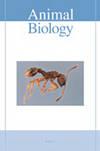Radiobiological studies on fall armyworm, Spodoptera frugiperda (J. E. Smith) (Lepidoptera: Noctuidae)
IF 0.9
4区 生物学
Q2 ZOOLOGY
引用次数: 0
Abstract
Abstract The fall armyworm, Spodoptera frugiperda (JE Smith, 1797) is a notorious invasive pest causing significant economic damage to various crops. The extensive damage caused by this pest has created havoc in India and has become a nightmare for farmers. The management steps taken for controlling the pest have become futile. There are several instances depicting the failure of conventional management tactics, viz resistance against insecticides and transgenic maize lines paving the way for exploiting newer paradigms of pest management. Hence, a novel approach through the use of gamma irradiation against the pest was attempted. A dose-response trial encompassing doses from 50 to 200 Gy was employed to study the adverse effects of gamma irradiation on the biology of fall armyworm. The irradiated insects were crossed with their counterpart and the developmental profile of progeny was analysed. The obtained results were quite promising and showed a significant effect on the biology of the pest with progression of the irradiation dose. When females were exposed to irradiation and crossed with fertile counterparts, fecundity decreased with an increase in irradiation dose. A considerable increase in the egg, larval and pupal period was observed at 100 and 150 Gy. This decreased fecundity reduces the pest’s build-up in the field and the prolonged developmental period make the pest more prone to biotic and abiotic annihilation factors. Hence, the above-mentioned strategy has plausible applications in the near future and this tool can better be fitted into area-wide integrated pest management programmes.秋粘虫,Spodoptera frugiperda (j.e. Smith)的放射生物学研究(鳞翅目:夜蛾科)
摘要:秋粘虫,Spodoptera frugiperda (JE Smith, 1797)是一种严重危害农作物经济的入侵害虫。这种害虫造成的广泛破坏在印度造成了严重破坏,成为农民的噩梦。为控制害虫而采取的管理措施已经无效了。有几个例子说明了传统管理策略的失败,即对杀虫剂的抗性和转基因玉米品系为开发新的虫害管理模式铺平了道路。因此,尝试了一种新的方法,即利用伽马射线照射来对付害虫。采用剂量为50 ~ 200 Gy的剂量反应试验研究了γ辐照对秋粘虫生物学的不良影响。对辐照后的昆虫进行杂交,分析其后代的发育情况。结果表明,随着辐照剂量的增加,对害虫的生物学特性有显著的影响。当雌性暴露在辐照下并与有生育能力的对应物杂交时,生殖力随辐照剂量的增加而下降。在100和150 Gy下,卵期、幼虫期和蛹期均显著增加。这种繁殖力的下降减少了害虫在田间的积累,而发育期的延长使害虫更容易受到生物和非生物消灭因素的影响。因此,上述战略在不久的将来具有合理的应用前景,这一工具可以更好地适用于全地区病虫害综合管理方案。
本文章由计算机程序翻译,如有差异,请以英文原文为准。
求助全文
约1分钟内获得全文
求助全文
来源期刊

Animal Biology
生物-动物学
CiteScore
2.10
自引率
0.00%
发文量
34
审稿时长
3 months
期刊介绍:
Animal Biology publishes high quality papers and focuses on integration of the various disciplines within the broad field of zoology. These disciplines include behaviour, developmental biology, ecology, endocrinology, evolutionary biology, genomics, morphology, neurobiology, physiology, systematics and theoretical biology. Purely descriptive papers will not be considered for publication.
Animal Biology is the official journal of the Royal Dutch Zoological Society since its foundation in 1872. The journal was initially called Archives Néerlandaises de Zoologie, which was changed in 1952 to Netherlands Journal of Zoology, the current name was established in 2003.
 求助内容:
求助内容: 应助结果提醒方式:
应助结果提醒方式:


